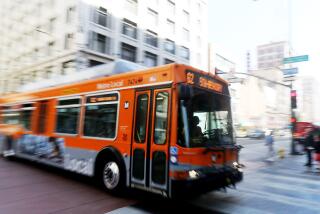For Better Safety, MTA Takes a Virtual Reality Check
- Share via
Soon, MTA bus drivers might be careening down the wrong side of a street, running red lights, knocking out pedestrians and smashing into tall buildings. And Angelenos will be better off for it.
The accidents are part of a video game-like world generated by a new virtual reality bus at the Metropolitan Transportation Authority’s training center.
The $400,000 bus simulator became part of the agency’s training program this week and is being used to improve defensive driving skills for both new and experienced operators.
“It’s similar to an aircraft simulator,” said Mark Anderson, director of operations training for the transit agency. “We can actually practice things in a safe environment, a controlled environment, that we can’t do on city streets.”
The MTA employs about 4,300 drivers. During morning and afternoon peak hours, about 2,000 Metro buses are crisscrossing Los Angeles County.
Last year, the agency logged 3,751 bus accidents, 145 of which resulted in injury or death. Most of the rest were minor incidents, such as fender-benders or clipped side mirrors. The figures don’t reflect who was at fault, and the overall accident rate is comparable to that of other large transit agencies, according to the MTA.
But accidents cost the agency more than $28.5 million annually in personal injuries and property damage liability.
“We’re constantly looking at new ways to reduce our accidents -- first and foremost is training,” said John Catoe, the agency’s deputy chief executive. “If you [prevent] one or two accidents, that can more than pay for the simulator.”
The new device is not the MTA’s first venture into virtual reality. Two years ago, the agency bought a $400,000 trailer containing a theater to present 3-D movies to raise public awareness on light-rail safety.
Audience members are strapped into seats that move to simulate the rumbling of a rolling train, and giant industrial-size fans create the feeling of acceleration. When a pedestrian stops on the tracks, the train makes an emergency stop and the theater’s seats lurch.
The virtual reality bus replicates the interior of a standard Metro coach. Equipped with a bucket seat, a large steering wheel and an instrument panel, it also has pedals for accelerating and braking. Surrounding the bus cab are five 60-inch projection screens and three 42-inch plasma screens offering drivers a 325-degree view.
Through the windshield, a driver sees animation images of a city street, with stop signs, traffic signals and oncoming cars. Side-view mirrors reflect the traffic behind the driver, minus blind spots.
Sitting a few feet away from the cab and screens, instructor Carlos Baez is at a computer, clicking a mouse to create conditions that drivers encounter. He selects “rain,” and the screens display a downpour, reducing visibility. “Wind” makes steering jerky and difficult.
Baez can make dashboard indicators light up to see if the trainee is paying attention to emergency alerts of engine failure, a flat tire or a fire in the passenger compartment. He can program pedestrians darting into the street or a car cutting into the path of the bus.
“You can set up scenarios, try to replicate dangerous situations,” Baez said.
First-time drivers who take the virtual bus for a spin learn the following: Just as in real life, the virtual bus won’t go anywhere -- no matter how insistently the accelerator pedal is pressed -- unless the parking brake is released.
A 40-foot bus has a turning radius much larger than that of a small Volvo, and failing to apply brakes in time can result in a cyber fender-bender.
The peaceful panorama jostles suddenly, and the computerized system belches out a “thump-thump” sound, when uneven steering causes the virtual bus to vault a curb, narrowly missing a man on a sidewalk.
The bus simulator could be used to weed out trainees who shouldn’t be allowed behind the wheel of a real bus, instructors say. Currently, about 25% of trainees flunk out because they fail a written test, lack customer service skills or can’t handle the actual driving.
New drivers marvel at the bus simulator. “It was amazing ... how realistic it was,” said Timothy Laprade, 22, a bus operator who just completed training. “It’ll give drivers more confidence ..., give them a pretty good feel for the bus before getting in one.”
More to Read
Sign up for Essential California
The most important California stories and recommendations in your inbox every morning.
You may occasionally receive promotional content from the Los Angeles Times.













